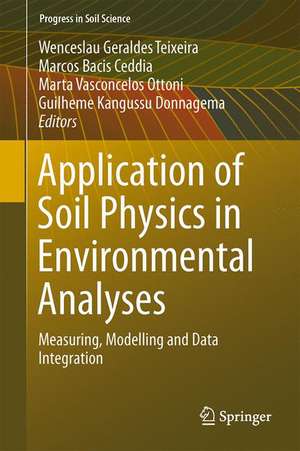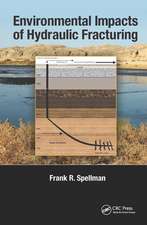Application of Soil Physics in Environmental Analyses: Measuring, Modelling and Data Integration: Progress in Soil Science
Editat de Wenceslau Geraldes Teixeira, Marcos Bacis Ceddia, Marta Vasconcelos Ottoni, Guilheme Kangussu Donnagemaen Limba Engleză Hardback – 11 iul 2014
Preț: 961.41 lei
Preț vechi: 1172.45 lei
-18% Nou
Puncte Express: 1442
Preț estimativ în valută:
183.99€ • 191.38$ • 151.89£
183.99€ • 191.38$ • 151.89£
Carte tipărită la comandă
Livrare economică 15-29 aprilie
Preluare comenzi: 021 569.72.76
Specificații
ISBN-13: 9783319060125
ISBN-10: 3319060120
Pagini: 499
Ilustrații: XXI, 499 p. 184 illus., 74 illus. in color.
Dimensiuni: 155 x 235 x 25 mm
Greutate: 0.9 kg
Ediția:2014
Editura: Springer International Publishing
Colecția Springer
Seria Progress in Soil Science
Locul publicării:Cham, Switzerland
ISBN-10: 3319060120
Pagini: 499
Ilustrații: XXI, 499 p. 184 illus., 74 illus. in color.
Dimensiuni: 155 x 235 x 25 mm
Greutate: 0.9 kg
Ediția:2014
Editura: Springer International Publishing
Colecția Springer
Seria Progress in Soil Science
Locul publicării:Cham, Switzerland
Public țintă
ResearchCuprins
Part 1 - Integrating data in soil physics.- Knowledge chains, linking cutting-edge research on flow phenomena in soils with tacit knowledge from field research.- Part 2 – Data analysis in soil physics and pedotransfers functions.- State-Space Analysis in Soil Physics.- Spatial relationships between soil water content and hydraulic conductivity in a highly structured clay soils.- State-space approach to understand Soil-Plant-Atmosphere relationships.- Pedotransfer functions for Brazilian soils.- Part 3 – Different approaches for the characterization of soil physical quality indicators.- An Algorithm for Mapping the Spatial Variability of Soil Physical Quality.- A Preliminary Proposal for the Structural Classification Of Soil Pore Space.- Indicators of soil physical quality: from simplicity to complexity.- Monitoring soil water in irrigated soils of the Brazilian semi-arid region: an opportunity to improve water use.- Sensor Network Data Assimilation in Soil Water Flow Modeling.- NewPerspectives for the Application of High-Resolution Benchtop X-Ray MicroCT for Quantifying Void, Solid and Liquid Phases in Soils.- Unsaturated soil hydraulic conductivity in the Central Amazon: field evaluations.- Soil Moisture and Soil Water Storage using Hydrological Modeling and Remote Sensing.- Part 5 - Creating databases and models applied to soil physics.- The Use of Numerical Flow and Transport Models in Environmental Analyses.- The Use of Multicomponent Solute Transport Models in Environmental Analyses.- Water availability to plants.- Experiences and challenges in developing European Soil hydrological Databases.- A Hydrophysical Database to develop Pedotransfer Functions for Brazilian Soils: Challenges and Perspectives.
Notă biografică
Wenceslau Geraldes Teixeira, an agronomist, got his degree in Agronomy from the Federal University of Viçosa in Brazil (1985 to 1989), his master degree in Soil Science from the Federal University of Lavras in Brazil (1990 to 1992) and his PhD in Soil Physics from University of Bayreuth in Germany (1998 to 2001). Since 1995, he has worked for the Brazilian Ministry of Agriculture at the Center of Brazilian Agricultural Research from the Occidental Region of Amazon (Embrapa - Amazonia Ocidental), Brazil and he is also an associate professor at the Federal University of the Amazon (UFAM). His work focuses on tropical soil management and conservation. The main research areas are: soil physical quality standards for tropical soils, characterization of anthropic soils (Terra preta de Índio) and use of charcoal as soil conditioner (biochar)”. He co-edited "Amazonian Dark Earths: Wim Sombroek's Vision", published by Springer in 2009.
Textul de pe ultima copertă
The importance to preserve soil and water is widely recognized. Soil physics has grown considerably in the last years, however, those advances are thoroughly dispersed. In this volume, the authors will bring together the effectiveness of new field and lab sensors and the state-of-the-art in modeling and data analysis. The topics have been divided as follows: Part 1 - Integrating data in soil physics proposes re-establishing the knowledge chain, linking tacit knowledge to cutting edge science. The use of field soil data or what has been called hydropedology, is discussed and exemplified. Part 2 - Data analysis in soil physics and pedotransfers functions presents the analysis of data in state-space and geostatistical approaches. Part 3 – Different approaches to characterize soil physical quality indicators is focused on new techniques used to characterize, map and interpret soil physical parameters. The challenge of assessing soil physical quality is discussed from the simplest to the most complex indicators. Part 4 - Sensors and monitoring in soil physics centers the discussion on equipment and sampling techniques for monitoring soil physical parameters. Technological advances are addressed, such as X-ray tomography, which provides a means to evaluate pore topological properties in a noninvasive way. A comparison with in situ and remotely sensed data of soil moisture and limitations in using these data for hydrological modeling are also discussed. Part 5 - Creating data bases and models applied to soil physics discusses alternative approaches for modeling water flow and solute transport in the vadose zone. A review of multi-component solute transport models and examples of their use in agricultural and environmental applications are given. The phenomenon of dynamic non-equilibrium in soil water flow is discussed as the need of a paradigm change. Root water uptake is also covered with advanced approaches and the last two chapters address the challenges to develop soil data bases.
Caracteristici
Unique in the state of art in advanced modeling and data analysis in soil physics edited by top scientists worldwide The knowledge that will be collected will be chance for researches and students to have a review of many "hot topics" in soil physics research Used as a guide from selecting sensors to investigate soil physics properties until modeling data and choosing statistical analysis































